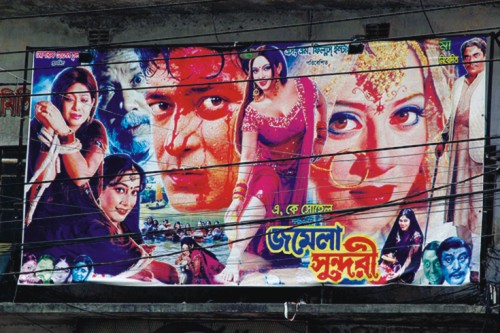
Inside
|
A Twist in the Tale Shayera Moula looks askance at the Bangla film industry We all know how the movie goes. There is a good guy and there is a bad guy. The former falls in love with a delicate beauty, i.e. the actress, and the latter tries to physically, mentally, and verbally abuse that delicate creature. It's quite difficult to call her a person, really. Her mute role in getting hold of her lover, her silence after being physically tormented, and her fragile state when awaiting the men in her life to make all the decisions for her, is, of course, silently amusing. But at times, it is just plain irritating. She is never capable of fighting for herself, and is always at a war of tug and pull between the men in her life -- her father, her brother, the villain, and, of course, she is ultimately handed down to her lover like a little blossom of tinkling treasure. At the end of the day, these are the moral films for the masses. The play of karma, of what goes around comes around, is vividly projected through the good guy winning in the end and the bad guy losing everything, including his life. Note how no one turns to capital punishment, to the courtroom of law and order to fight out these battles. These action sequences consist of raw man-to-man punches and kicks -- just like it was done in the good old days. Lots of bleeding, lots of slitting of the throats and hands, and lots of sudden sword-piercing into other people's hearts, stomachs, and backs. Then there is the up close and personal rape scene in every movie. The message to the viewers is "this is wrong" -- and yet the details of this scene are very traumatic and exceptionally well thought out in terms of obscenity, vulgarity, and humiliation and degradation. In fact, there are, at times, witnesses of the victim tied up in front of her. Sometimes these witnesses are her very own family members -- mother, brother, father, and so on. An interesting entwining of various complexes is reached, too, where the role of the father in guarding his daughter's sexuality is lost, and so he fails himself as a father, as a husband and as a man. At other times, there are many men together pulling Ms. Beauty from one guy to another, all laughing at the top of their voices, somewhat of a chronicle apprehension of those early Bollywood movies of the 1990s. It's true. Maduri Dixit must have gotten raped a dozen times around that era, and in many disturbingly innovative ways, too. The heightened hyper-sexuality of women in these movies is as disconcerting as it is perverse. So there she is -- a victim of rape -- and note how the camera and her clothes make sure to highlight her body to its fullest. The question is: How many men in the movie theatre are really disturbed by this scene and how many of them are actually enjoying the spots of revealed flesh? Where the message ostensibly says "don't do it" -- how many get it and how many are silently eager about this part of the movie?
A study done by UNESCO showed that 75% of Hindi films, too, had either physical or verbal violence shown in them, where the actual percentage of rapes were between 12 to 16% (1949 and 1997) From the 80s to 90s, 7 out of 10 movies had such gruesome scenes in them. A rape scene is also identified as the ‘item’ scene, where filmmakers take advantage and turn the concept ‘rape’ into titillation. They manage to sexualise the film without offending the censors. Then there is the good-evil binary. Something that is too complicated to venture into because these movies are trying to engrave the concept of good and bad on the minds of the audience. Naturally without much success, otherwise the nation would be a "good" one. Still so, let's leave that thought out of the picture, simply because these movies are meant for entertainment and nothing more. But within the lights of entertainment, there is a gray area of what is really being projected. When claiming that harassing a girl on the street is a bad thing, at times the main hero of the movie holds the heroine's attention the same way. He irritates her, sings her a song, and plays around with her stubbornness until finally she gives in. So, when a better-looking man from a good background eve-teases and sexually harasses you, that's OK? Sure, the movie-makers of the country aren't really concerned about it, and the audience of the movies doesn't feel too threatened with or without the message. But if there are about ten Bangla channels, all showing such a movie almost every day, sometimes one would wish to have something a little more sensible on display -- something that actually suggests morality -- or is that asking too much? Shayera Moula is Editorial Assistant, The Daily Star. |
